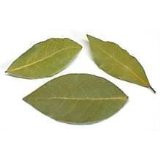 Loading... Please wait...
Loading... Please wait...- Home
- Indian Spices
- Whole Spices
- Bay Leaves (Tejpata) 1oz-Indian Grocery,Spice,Spice mix,USA
- Home
- Indian Curry Spice
- Indian Spice
- Bay leaves
- Bay Leaves (Tejpata) 1oz-Indian Grocery,Spice,Spice mix,USA
Bay Leaves (Tejpata) 1oz-Indian Grocery,Spice,Spice mix,USA
Product Description
Bay Leaves (Tejpata).Spice Description The bay leaf is oval, pointed and smooth, 2.5 - 8 cm (1 to 3 in) long. When fresh, the leaves are shiny and dark green on top with lighter undersides. When dried the bay leaf is a matte olive green. Bouquet: Warm and quite pungent when broken and the aromatic oils are released. Flavour: Slightly bitter and strongly aromatic. Culinary Uses Bay leaves are widely used throughout the world. It may be best known in bouquets garnis or used similarly in soups, sauces, stews, daubes and courts-bouillons, an appropriate seasoning for fish, meat and poultry. Bay leaf is often included as a pickling spice. Bay leaf has many properties which make it useful for treating high blood sugar, migraine headaches, bacterial and fungal infections, and gastric ulcers. Bay leaves and berries have been used for their astringent, carminative, diaphoretic, digestive, diuretic, emetic and stomachic properties. Bay Oil, or Oil of Bays (Oleum Lauri) is used in liniments for bruising and sprains. Bay leaf has been used as an herbal remedy for headaches. It contains compounds called parthenolides, which have proven useful in the treatment of migraines. Bay leaf has also been shown to help the body process insulin more efficiently, which leads to lower blood sugar levels.It has also been used to reduce the effects of stomach ulcers. Bay Leaf contains eugenol, which has anti-inflammatory and anti-oxidant properties. Bay leaf is also an anti-fungal and anti-bacterial. Bay Leaf has also been used to treat rheumatism, amenorrhea, and colic.










